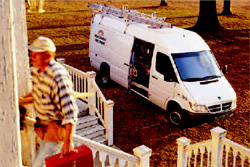There are a few drawbacks to utilizing tractor trailers, however. “You really need to have a truck driver; they need to know how to drive a truck in traffic and know how to turn,” Zito points out. Also, tractor trailers do not have off-road capabilities.
Over Haulin’ Standard truck bodies and beds, such as dumps, roll beds, van and contractor bod-ies,flat beds,landscape beds,and box trailers, are still versatile enough to carry a wide range of materials. But dealers are finding more creative ways to utilize their delivery systems for greater efficiency and customer satisfaction. For example, many dealers are opting for truck-mounted forklifts (like those by Moffett, Princeton Delivery Systems, and Sellick Equipment) and truck-mounted cranes (such as those made by Hiab Cranes and IMT) to place materials exactly where the customer will need them.
Some dealers are even trying out new truck body types in an effort to increase efficiencies, such as demountable box trailers that allow one box to be loaded in the yard while another is on a truck out for delivery.
Deliveries of smaller loads as well as sensitive materials like windows and wood moldings are more frequently made using a commercial delivery van, like the tall and narrow Dodge Sprinter, or a truck chassis with a van body. Bins, tie-downs, and other accessories secure the materials in the van and protect them from damage.
Down the road, as the construction industry changes dealers must continue to find more innovative ways to meet their customers’ needs and demands while maintaining efficiencies and keeping operating costs down. Evaluating how best to leverage your delivery trucks and equipment can give you a distinct advantage over the competition.
Sidebar: Ticket to Ride A fleet maintenance program is critical to keeping vehicles on the road and maximizing return on investment.
No matter what road conditions you face or how old your fleet is, your trucks need to work reliably. But how do you make sure that your fleet operates to its maximum potential? Fleet management strategies can vary from a minimalist calendar and checklist to maintenance-tracking software programs.
A business with a large fleet might find it more convenient and cost effective to handle routine maintenance with in-house mechanics, sending trucks to the local truck dealer for bigger or more sensitive repairs. Some dealers prefer to handle all maintenance and repairs in-house, however, a tactic that allows for more cost control by reducing unnecessary parts replacements and managing downtime. An in-house mechanic shop also keeps all maintenance trends under the fleet manager’s eye. “When a truck is down, we have the ability to get it back up and rolling because we have our own mechanics, instead of being at the mercy of the local dealer,” says Charlie Babb, president of North Fort Myers, Fla.–based Raymond Building Supply.
National Lumber in Warren, Mich., operates a 22-hour maintenance facility with a staff of full-time mechanics to service its 103-vehicle fleet. Fleet operations are centralized, making it easy for the fleet manager to monitor all aspects of the fleet. “We eat and breathe equipment, and tread life, and wear and tear,” says president Jim Rosenthal. Each piece of equipment is examined once a month, and National Lumber tracks every repair, replacement, oil change, and other data in the computer. The fleet manager dissects the information and provides a summary report to Rosenthal every month. With this kind of approach, a dealer can quickly recognize fleet trends and problems and take action to correct issues.
Keeping a fleet in top condition also requires cycling trucks in and out as the vehicles age. Deciding when to retire trucks is a challenge, but can be made easier by tracking wear and tear over the years. “When we were keeping vehicles for eight years, what we determined was that the last three years of that vehicle’s life was when we spent the most money repairing it,” notes Greg Lucas, CFO for Marietta, Ga.-based Robert Bowden Inc. (RBI). Starting this year with an all-new leased fleet, RBI will begin cycling trucks out every five years. “By rotating our fleet every five years now, we’ll be getting newer and better fuel-efficient technology.”

